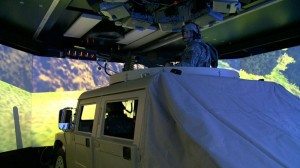 GRAFENWOEHR, Germany: The Army’s newest virtual training device is open for business to U.S. Army Europe Soldiers at the Grafenwoehr Training Area.
GRAFENWOEHR, Germany: The Army’s newest virtual training device is open for business to U.S. Army Europe Soldiers at the Grafenwoehr Training Area.
The Reconfigurable Vehicle Tactical Trainer, or RVTT, officially opened during a ribbon-cutting ceremony on the training area’s Camp Aachen, Feb. 18.
The RVTT is unlike traditional computer simulators or engagement skills trainers because it surrounds Soldiers in a realistic, 360-degree virtual world, said David W. Darnall, Soldier Program Manager for the 7th Army Joint Multinational Training Command (JMTC).
“In any other computer simulations you’re constrained by a 14, 18 or 19-inch monitor that you view your world through,” said Darnall.
“All of the RVTT simulators that we have are 360 degrees,” said Darnall. “There’s no such thing as moving your mouse to glance right. In here, you glance right and you see the terrain moving. It becomes much more immersive.”
The RVTT system consists of a series of four to five trailers, said Darnall. Two of the trailers are equipped with life-size replica HMMWVs surrounded by floor-to-ceiling movie screens. A third trailer provides command and control capabilities. A fourth trailer provide power to the whole system.
The fifth trailer contains spare parts – such as extra weapons or vehicle pieces – that allow units to reconfigure the simulators to meet their training needs, said Darnall.
The system can accommodate a whole platoon training simultaneously on the same mission, said Darnall.
“The last (simulator) we did was not this advanced,” said Spec. Selah Hadi, who went through the RVTT as part of the JMTC’s Theater Specific Individual Readiness Training (TSIRT) course.
“This was more realistic, fun, I mean. I always enjoy doing stuff like this,” said Hadi.
The RVTT simulators can save commanders immense time, particularly when the unit is conducting complex training missions, said Darnall.
“For example, say a commander wanted to go out to (Grafenwoehr’s) Range 118 and do convoy training with IEDs,” said Darnall. “If he has a really good day and his Soldiers are motivated, maybe he can do three iterations with his platoon. Here in the virtual simulator, you could easily do ten to 12 repetitions a day.”
Virtual mission training is also cheaper for the unit because they don’t have to worry about the cost of fuel or ammunition, said Darnall.
“We’re just spending electrons here,” said Darnall.
Each RVTT scenario is fully-customizable by the training unit, said Darnall. Currently, the RVTT has access to eight terrain databases, which include northern California, the National Training Center, and the ranges and training sites of the JMTC’s Grafenwoehr and Hohenfels Training Areas.
Even though it looks like a giant arcade game, the Army has made all the scenarios and the simulator equipment as realistic as possible, said Darnall.
“You’re going to have the same rate of acceleration in (RVTT’s) HMMWV. You’re going to have the same rate of fire on that weapon as you would in real life,” said Darnall. “You have to do the things you would normally do to be successful.”
The entire RVTT system is transportable, said Darnall, but the goal is to make it a permanent piece of what will eventually become U.S. Army Europe’s first Virtual Device Training Facility.
In addition to RVTT, the JMTC’s Virtual Device Training Facility(VDTF) will eventually also incorporate the current armored vehicle simulators (Mobile Close Combat Tactical Trainers) and the Virtual Battle Space 2 desktop mission simulators with the future Dismounted Soldier Virtual Trainer, a system that will allow up to 12 Soldiers to physically maneuver through a three-dimensional virtual world with the use of goggles and body sensors, said Darnall.
When it’s fully operational, the VDTF will be able to simultaneously train up to a battalion of soldiers in one location on virtual missions, said Darnall.
“Right now we don’t have the capability to plug everything together,” said Darnall. “When we get the other simulators that are coming in, they will arrive being able to be plugged into each other.”
“Beyond that, the only limitation is what the unit commander’s imagination is,” said Darnall.









